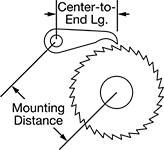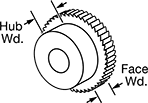About Roller Chain and Sprockets
More
About Gears
More
Sprockets for Metric Roller Chain
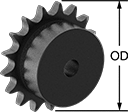
Designed to meet ISO 606 and DIN 8187 international dimensional standards, these sprockets are for use with compatible ISO and DIN roller chain. They come machined to the shaft diameter size listed and are machinable up to the maximum shaft diameter size.
| Number of Teeth | For Shaft Dia., mm | For Max. Shaft Dia., mm | OD, mm | Overall Wd., mm | Hub Dia., mm | Material | Specifications Met | Each | |
For ISO 05B Roller Chain (8 mm Pitch) | |||||||||
|---|---|---|---|---|---|---|---|---|---|
| 21 | 8 | 25 | 57.5 | 14 | 35 | Steel | DIN 8187, ISO 606 | 0000000 | 000000 |
| 22 | 8 | 25 | 60 | 14 | 35 | Steel | DIN 8187, ISO 606 | 0000000 | 00000 |
| 23 | 8 | 17 | 62 | 14 | 35 | Steel | DIN 8187, ISO 606 | 00000000 | 00000 |
| 24 | 8 | 17 | 64.6 | 14 | 35 | Steel | DIN 8187, ISO 606 | 00000000 | 00000 |
| 25 | 8 | 25 | 67.5 | 14 | 35 | Steel | DIN 8187, ISO 606 | 0000000 | 00000 |
Metal Gears and Gear Racks—20° Pressure Angle
The current industry standard, these 20° pressure angle gears have thicker, stronger teeth than 14½° pressure angle gears. Compared to plastic gears and racks, they’re better for high-load, high-speed, and heavy duty applications. Also known as spur gears.
Combine gears with different numbers of teeth to change speed and torque in your assembly. Combine a gear and rack to convert rotary motion into linear motion. To minimize your footprint, mount one or more standard gears inside of an internal gear.
For components to mesh correctly, they must have the same pressure angle and pitch/module.
Carbon steel components have hard, strong, and wear-resistant teeth, although they will rust when exposed to moisture and corrosive chemicals. They're best for high-torque machines, like lifting equipment, and heavy duty applications, such as rock crushing. Gears with teeth that are not hardened can be hardened to fit your application.
Stainless steel gears and racks resist rust in damp and wet environments, so they're commonly used in food-processing plants and other areas with frequent cleaning.
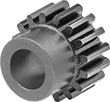
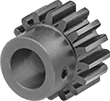
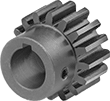
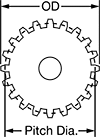
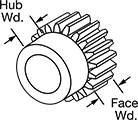
Hub | Keyway | ||||||||||||||
|---|---|---|---|---|---|---|---|---|---|---|---|---|---|---|---|
| Module | Number of Teeth | Gear Pitch Dia., mm | OD, mm | Face Wd., mm | Overall Wd., mm | For Shaft Dia., mm | Material | Teeth Heat Treatment | Dia., mm | Wd., mm | Set Screw Thread Size | Wd., mm | Dp., mm | Each | |
Round Bore | |||||||||||||||
| 1 | 40 | 40 | 42 | 10 | 20 | 10 | 303 Stainless Steel | Not Hardened | 35 | 10 | __ | __ | __ | 00000000 | 000000 |
| 1 | 42 | 42 | 44 | 10 | 20 | 10 | 303 Stainless Steel | Not Hardened | 35 | 10 | __ | __ | __ | 00000000 | 00000 |
| 1 | 48 | 48 | 50 | 10 | 20 | 10 | Black-Oxide 1045 Carbon Steel | Not Hardened | 35 | 10 | __ | __ | __ | 00000000 | 00000 |
| 1 | 50 | 50 | 52 | 10 | 20 | 10 | 303 Stainless Steel | Not Hardened | 35 | 10 | __ | __ | __ | 00000000 | 00000 |
| 1 | 55 | 55 | 57 | 10 | 20 | 10 | Black-Oxide 1045 Carbon Steel | Not Hardened | 35 | 10 | __ | __ | __ | 00000000 | 00000 |
Round Bore with Set Screw | |||||||||||||||
| 1 | 40 | 40 | 42 | 10 | 20 | 8 | Black-Oxide 1045 Carbon Steel | Not Hardened | 35 | 10 | M5 | __ | __ | 00000000 | 00000 |
| 1 | 45 | 45 | 47 | 10 | 20 | 8 | Black-Oxide 1045 Carbon Steel | Not Hardened | 35 | 10 | M5 | __ | __ | 0000000 | 00000 |
| 1 | 45 | 45 | 47 | 10 | 20 | 8 | Black-Oxide 1045 Carbon Steel | Not Hardened | 35 | 10 | M5 | __ | __ | 00000000 | 00000 |
| 1 | 50 | 50 | 52 | 10 | 20 | 8 | Black-Oxide 1045 Carbon Steel | Not Hardened | 35 | 10 | M5 | __ | __ | 00000000 | 00000 |
Keyed Bore with Set Screw | |||||||||||||||
| 1 | 60 | 60 | 62 | 10 | 20 | 10 | Black-Oxide 1045 Carbon Steel | Not Hardened | 35 | 10 | M4 | 4 | 1.8 | 00000000 | 00000 |
| 1 | 60 | 60 | 62 | 10 | 20 | 12 | Black-Oxide 1045 Carbon Steel | Not Hardened | 35 | 10 | M4 | 4 | 1.8 | 0000000 | 00000 |
High-Power Metal Gears

and Crossed Left-Hand
Gear (Sold Separately)

Right-Hand Teeth
(Sold Separately)
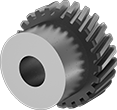
The helical teeth on these gears stay in contact for longer than straight teeth, which allows them to transmit higher loads at higher speeds than spur gears.
For gears to mesh correctly, they must have the same pressure angle and pitch. All of these gears transmit motion in a straight line—make sure to get one left-hand and one right-hand gear. To change speed and torque in your assembly, pair two gears with different numbers of teeth.
Crossed helical gears, also known as screw gears, can be configured to transmit motion at a 90° angle. To transmit motion at a 90° angle, pair two gears with the same tooth direction. To avoid wearing down gears, which happens when you use the same material, we recommend mating gears with different materials. Made from carbon steel, these gears are strong, but not as strong as alloy steel gears.

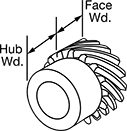
Hub | ||||||||||||
|---|---|---|---|---|---|---|---|---|---|---|---|---|
| Module | Number of Teeth | Helix Angle | Gear Pitch Dia., mm | OD, mm | Face Wd., mm | Overall Wd., mm | For Shaft Dia., mm | Teeth Heat Treatment | Dia., mm | Wd., mm | Each | |
Left Hand | ||||||||||||
Round Bore—Black-Oxide 1045 Carbon Steel | ||||||||||||
| 1 | 30 | 45° | 42 | 44.43 | 10 | 20 | 10 | Not Hardened | 35 | 10 | 00000000 | 000000 |
Right Hand | ||||||||||||
Round Bore—Black-Oxide 1045 Carbon Steel | ||||||||||||
| 1 | 30 | 45° | 42 | 44.43 | 10 | 20 | 10 | Not Hardened | 35 | 10 | 00000000 | 00000 |
Metal Worms and Worm Gears

Worm gears use screw threads to make large reductions to shaft speed while transmitting motion at a right angle. They transmit motion from worm to gear and cannot be reversed. For gears and worms to mesh correctly, they must have the same pressure angle, pitch/module, number of thread starts, and thread direction. These worms are compatible with plastic worm gears.
Speed ratio is the ratio by which output shaft speed is reduced. As speed decreases, torque increases.
Cast iron gears are strong and durable.
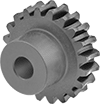


Hub | |||||||||||||||||
|---|---|---|---|---|---|---|---|---|---|---|---|---|---|---|---|---|---|
| Module | Speed Ratio | Number of Teeth | Pressure Angle | Gear Pitch Dia., mm | For Number of Thread Starts | OD, mm | Face Wd., mm | Overall Wd., mm | For Shaft Dia., mm | Dia., mm | Wd., mm | Material | For Thread Direction | Teeth Heat Treatment | Teeth Fabrication | Each | |
Round Bore—Cast Iron | |||||||||||||||||
| 1 | 80:1 | 80 | 20° | 80 | 1 | 83 | 10 | 20 | 10 | 35 | 10 | Cast Iron | Right Hand | Not Hardened | Not Ground | 000000000 | 000000 |
| 2.5 | 10:1 | 20 | 20° | 50 | 2 | 57.5 | 22 | 36 | 12 | 35 | 14 | Cast Iron | Right Hand | Not Hardened | Not Ground | 000000000 | 00000 |
Metal Bevel Gears


A type of miter gear where one gear (sometimes called a pinion) is smaller than the other, bevel gears provide right-angle speed reduction at speed ratios ranging from 2:1 to 5:1. All are carbon steel for strength; they're compatible with plastic bevel gears. Teeth are not hardened so you can harden them to fit your application. Hardening a gear’s teeth increases its wear resistance.
A complete set consists of a gear and pinion (sold separately). For a gear and pinion to mesh correctly, they must have the same pressure angle, pitch/module, and face width. Speed ratio is the ratio by which shaft speed is reduced when transferring motion from pinion to gear. To increase shaft speed, transfer motion from gear to pinion. Changing shaft speed also changes torque: as speed decreases, torque increases.


Hub | ||||||||||||||
|---|---|---|---|---|---|---|---|---|---|---|---|---|---|---|
| Face Wd., mm | Module | Pressure Angle | Speed Ratio | Number of Teeth | Gear Pitch Dia., mm | OD, mm | Overall Wd., mm | For Shaft Dia., mm | Mounting Distance (A), mm | Dia., mm | Wd., mm | Material | Each | |
Round Bore | ||||||||||||||
| 11 | 2 | 20° | 3:2 | 30 | 60 | 61.7 | 27 | 10 | 40 | 35 | 15 | Black-Oxide 1045 Carbon Steel | 00000000 | 000000 |


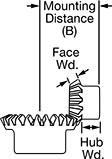
Hub | ||||||||||||||
|---|---|---|---|---|---|---|---|---|---|---|---|---|---|---|
| Face Wd., mm | Module | Pressure Angle | Speed Ratio | Number of Teeth | Gear Pitch Dia., mm | OD, mm | Overall Wd., mm | For Shaft Dia., mm | Mounting Distance (B), mm | Dia., mm | Wd., mm | Material | Each | |
Round Bore | ||||||||||||||
| 11 | 2 | 20° | 3:2 | 20 | 40 | 44.2 | 25 | 10 | 45 | 30 | 12 | Black-Oxide 1045 Carbon Steel | 00000000 | 000000 |
Plastic Gears and Gear Racks—20° Pressure Angle
The current industry standard, these 20° pressure angle gears have thicker, stronger teeth than 14½° pressure angle gears. Made of plastic, they run quieter than metal gears and have good corrosion and chemical resistance. They’re also known as spur gears.
Combine gears with different numbers of teeth to change speed and torque in your assembly. Combine a gear and rack to convert rotary motion into linear motion.
For components to mesh correctly, they must have the same pressure angle and pitch/module.
Nylon gears can be operated without lubrication, so they’re commonly used in food-processing machines.



Hub | |||||||||||||
|---|---|---|---|---|---|---|---|---|---|---|---|---|---|
| Module | Number of Teeth | Gear Pitch Dia., mm | OD, mm | Face Wd., mm | Overall Wd., mm | For Shaft Dia., mm | Material | Fabrication | Color | Dia., mm | Wd., mm | Each | |
Round Bore | |||||||||||||
| 1 | 40 | 40 | 42 | 10 | 20 | 10 | Nylon Plastic | Machined | Blue | 35 | 10 | 00000000 | 000000 |
| 1 | 50 | 50 | 52 | 10 | 20 | 10 | Nylon Plastic | Machined | Blue | 35 | 10 | 00000000 | 00000 |
| 1 | 60 | 60 | 62 | 10 | 20 | 10 | Nylon Plastic | Machined | Blue | 35 | 10 | 00000000 | 00000 |
Metal Ratcheting Gears
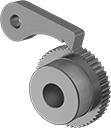
Compared to plastic gears, these metal ratcheting gears are better for high-load, high-speed, and heavy duty applications. Used to prevent unwanted motion in jacks, tie downs, clutches, and winches, ratchet gears have sloped teeth that allow motion in one direction and prevent it in the other.
Gears with hardened teeth are more wear resistant than gears with teeth that are not hardened.


























